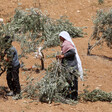Rights and Accountability 30 August 2021

Omar Abu al-Nil, 13, died from his wounds after Israeli snipers shot him in the neck during a protest on 21 August in Gaza.
Defense for Children International PalestineA Palestinian boy died from his wounds on Saturday after Israeli forces shot him in the neck last week.
The lethal attack on 13-year-old Omar Hasan Abu al-Nil occurred during a protest on 21 August east of Gaza City’s Shujaiya neighborhood, near the boundary fence with Israel.
Omar was observing the demonstrations 70 to 100 meters from the fence when an Israeli sniper fired a live round at him, according to a field investigation by Defense for Children International Palestine.
He lost consciousness immediately, witnesses said.
The boy was taken to al-Shifa hospital for surgery and remained in intensive care for several days. He died shortly after midnight on 28 August.
Omar was one of 24 children injured by Israeli occupation forces on that day. At least three other children were shot with live ammunition in their lower limbs.
Omar’s death brings to 73 the number of Palestinian children killed by Israeli forces in the occupied West Bank and Gaza Strip since the beginning of the year.
“Israeli forces routinely shoot and kill Palestinian children with impunity in circumstances that suggest unlawful and wilful killings,” Ayed Abu Eqtaish, DCIP’s accountability program director, said.
Abu Eqtaish called on the so-called international community “to hold Israel accountable by ending weapons sales and support for Israeli forces.”
Israeli snipers deployed on sand berms at the boundary with Gaza fired live ammunition, rubber-coated steel bullets and tear gas canisters at demonstrators, injuring more than forty that day.
Israel’s gunfire also claimed the life of a Palestinian man – Osama Khaled Dueij, 31 – last week who was injured during the same protests.
Tweets from the United Nations children’s agency UNICEF about Omar’s injury and death attracted criticism when they failed to name Israeli forces as the perpetrators.
Meanwhile, Israel’s official propaganda app Act.IL urged its users to post comments online blaming Hamas for the child’s death to deflect Israel’s responsibility. An Israeli sniper who was shot on 21 August with a bullet in the head while he was shooting at Palestinians in Gaza succumbed to his wounds on Monday.Barel Hadaria Shmueli of Israel’s Border Police was shooting at Palestinians through a small opening in the Israel-controlled separation wall with the Gaza Strip during the protests.
In footage circulated by local media that day, Palestinians are seen trying to take down the soldier’s gun poking through the opening using sticks and rocks.
An individual is then seen approaching, pulling out a handgun and shooting through the opening in the wall.
The Israeli army later identified the injured sniper as Shmueli.
Collective punishment
Meanwhile, the Israeli military carried out airstrikes in Gaza on Saturday night after incendiary balloons were launched from the territory into southern Israel, and Palestinians held after-dark protests near Malaka – an area east of Gaza City.
Despite the Israeli army’s claim that its bombing attacks targeted Hamas military sites in the Strip, local media reported people’s homes being damaged:
Israeli troops injured at least 11 Palestinians protesting near the Israel-Gaza boundary fence earlier on Saturday, some with live fire.Palestinians are protesting Israel’s ongoing siege on Gaza – a permanent and relentless attack on the entire civilian population of more than two million people in the coastal enclave, half of them children.
The siege is the backdrop for successive Israeli military assaults that have devastated Gaza’s economy, destroyed basic infrastructure and weakened major industries and sectors. It also isolates Gaza from the rest of Palestine and the world.
Israel imposes collective punishment on Gaza by conditioning any easing of restrictions – like allowing certain goods to enter the Strip, permitting some Palestinians in Gaza to work in Israel, or extending the permitted fishing area off Gaza’s coast – on whether Palestinians there resist Israel’s violence.
Moshe Tetro, the new officer for Gaza at COGAT – the bureaucratic arm of Israel’s military occupation – told Palestinians in Gaza that following Israel’s 11-day bombing campaign in May, “you have two options.”
He claimed in a video Sunday that their choices are “between terrorism or economy. Between violence and growth.”
Tetro’s threatening message was given amid a backdrop of happy images, including children playing and people working.
It is in keeping with COGAT’s efforts to falsely portray itself as a humanitarian body, instead of as what it really is: a military unit that deliberately harms civilians in order to try to force Palestinians to surrender to Israeli subjugation.
On Thursday, Egyptian authorities partially reopened the Rafah crossing, the Gaza Strip’s only passenger link to the outside world not directly controlled by Israel.
The crossing was only open for one day and only to those who wanted to enter Gaza.
Egypt indefinitely shuttered the crossing on 23 August in response to the protests during which Omar and Dueij were fatally shot, to assist Israel in collectively punishing the population in Gaza.




